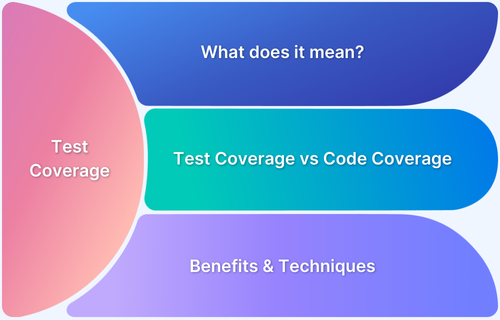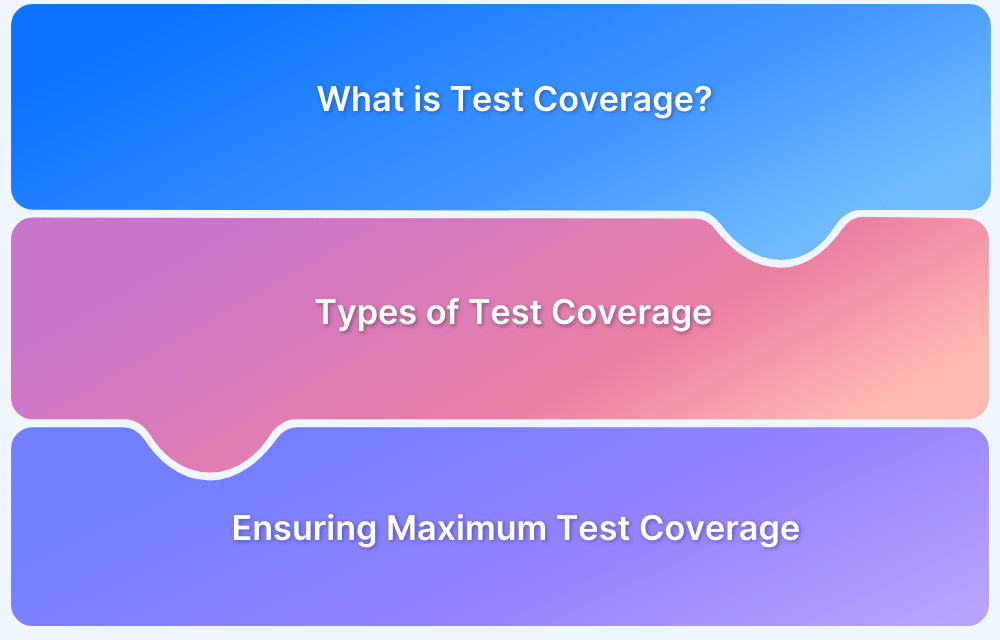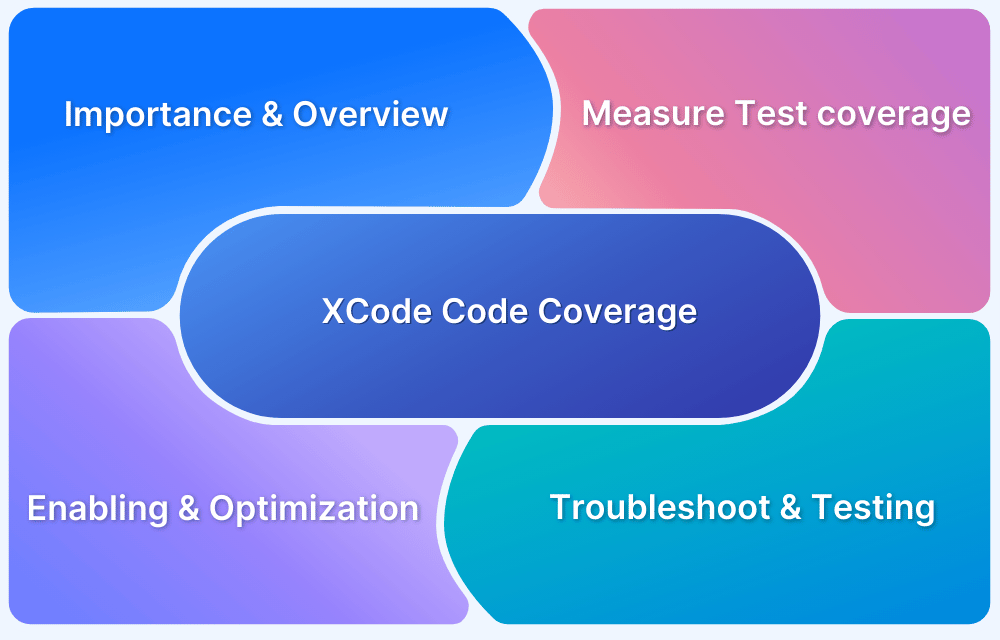Code coverage and test coverage are two important terminologies in software testing, which serve different purposes.
Overview
What is Code Coverage?
Code coverage measures the percentage of code executed during testing in comparison with the source code.
What is Test Coverage?
Test coverage checks the extent to which testing covers requirements, user scenarios, and potential risks.
Code Coverage vs Test Coverage
The basic difference between code coverage and test coverage is that:
Code coverage helps identify untested parts of the codebase, while test coverage ensures that all critical functionalities, edge cases, and business requirements are tested.
This article explores code coverage and test coverage in detail, covering various aspects like their differences and more.
What is Code Coverage?
Code coverage is a white-box testing technique performed to verify the extent to which the code has been executed. Code coverage tools use static instrumentation in which statements monitoring code execution are inserted at critical junctures in the code. Now, adding instrumentation code does result in increased execution time and code length. But the increase is more than justified in light of the tester’s information because of the extra code.
Code coverage scripts generate a report that details how much of the application code has been executed.
Why perform Code Coverage?
Code coverage is primarily performed at the unit testing level. Unit tests are created by developers, thus giving them the best vantage from which to decide what tests to include in unit testing. At this point, code coverage answers several questions, such as:
- Are there enough tests in the unit test suite?
- Do more tests need to be added?
As development progresses, new features and fixes are added to the codebase. The test code must be changed to stay updated with these changes. Testing standards established at the beginning of the project must also be maintained throughout subsequent release cycles. Code coverage ensures these standards are maintained so that only the optimal quality code is pushed to production.
A high percentage of code coverage results in lower chances of unidentified bugs. It is best to set a minimum rate of code coverage that must be achieved before testing in production to reduce the chances of bugs being detected later in development.
Advantages of Code Coverage
Here are the main advantages of code coverage:
- Quantitative: Code coverage offers results in quantitative metrics, which helps developers gauge the nature and health of their code.
- Allows Test Case Introduction: If available test cases do not test the software extensively enough, one can introduce their test cases to establish a robust coverage.
- Dead code & Error Elimination: Let’s say some parts of the entire codebase were not touched during code coverage, or there are sections of dead or useless code. Code coverage allows easy removal of such codes and errors to improve the code base efficiency.
Levels of Code Coverage
Here are the various levels of code coverage:
- Branch Coverage: This ensures that every branch in a decision-making process is executed. Let’s say a tester includes a fallback for cross-browser compatibility using an If…else conditional statement or a Do…While statement in the code. Branch coverage will ensure that all branches (If, Else, Do, While) are tested with appropriate input.
- Function Coverage: This ensures that all necessary functions are tested and also includes testing functions with different input parameters to test the logic.
- Statement Coverage: The code is created so that every executable statement in the source code is executed at least once. This includes corner cases or boundary cases.
- Loop Coverage: This ensures that every loop in the source code is executed at least once. Specific loops may be performed based on results achieved at runtime. One must be careful to test such loops to fortify the code thoroughly.
- Condition Coverage: This reveals how variables in conditional statements are evaluated. It helps to provide proper coverage to the control flow.
- Finite State Machine Coverage: This works based on the frequency of visits from static states and other transactions. Finite state machine coverage is the most complicated form of code coverage as it functions on the design of the software structure.
Code coverage verifies with instrumentation. Instrumentation monitors performance, inserts trace information and detects errors in the source code. The types of instrumentation are discussed below.
Instrumentation Types
- Code instrumentation: Source code is compiled after inserting instrumentation statements. The compilation is best done using the normal toolchain. Successful collection creates instrumented assembly.
- Runtime instrumentation: Instrumentation statements gather information from the runtime environment i.e. when the code is running.
- Intermediate code instrumentation: An instrumented class is created by adding byte codes to the compiled class files.
There are various types of code coverage metrics that developers can use to measure the effectiveness of their tests. Some of the most common metrics include:
- Statement coverage: % of statements in the code the tests execute.
- Branch coverage: % of decision points in the code executed by the tests.
- Function coverage: % of functions in the code the tests execute.
- Line coverage: % of lines of code executed by the tests.
Now that we’ve drawn on what is code coverage in all its intricacies let’s move on and explore test coverage.
How to Measure Code Coverage?
Here are some of the methods to be used for measuring code coverage:
1. Use code coverage tools like Istanbul for JavaScript, JaCoCo for Java, Coverage.py for Python, etc. to track executed code during tests.
2. Run the complete test suite from execution to integration, and end-to-end tests for monitoring.
3. Leverage tools to obtain detailed reports (HTML, XML, or JSON) highlighting covered and uncovered code sections.
4. Check for the key metrics like:
- Standard coverage: Percentage of executed statements
- Branch coverage: Percentage of executed decision branches
- Function coverage: Percentage of called functions/methods
- Line coverage: Percentage of executed lines in the code
- Path coverage: Confirms that all the possible execution paths are tested
Read More: Code Coverage Techniques and Tools
Best Code Coverage Tools
Here are some of the best code coverage tools you can use for reliable results:
1. JaCoCo
JaCoCo is an open-source Java code coverage tool that provides detailed insights into code coverage metrics, including line and branch coverage. It integrates seamlessly with build tools like Maven and Gradle, and IDEs such as Eclipse, making it a popular choice among Java developers.
2. Cobertura
Cobertura is a free code coverage tool for Java applications, supporting multiple coverage metrics and generating reports in formats like HTML and XML.
3. OpenClover
OpenClover is an open-source code coverage tool for Java and Groovy, based on the Clover tool originally developed by Atlassian. It offers rich reporting, including method, statement, and branch coverage, and integrates with various build tools and IDEs to identify untested parts of the codebase.
4. Bullseye Coverage
Bullseye Coverage is an advanced code converge tool designed for C and C++ programs that provides precise coverage analysis. It integrates with various development environments and supports multiple platforms, offering detailed reports to help improve test effectiveness.
Read More: Java Debugging Tools and Techniques
What is Test Coverage?
Unlike code coverage, test coverage is a black-box testing technique that monitors the number of tests that have been executed. Test cases are written to ensure maximum coverage of requirements outlined in multiple documents, such as:
- FRS (Functional Requirements Specification)
- SRS (Software Requirements Specification)
- URS (User Requirement Specification)
The test coverage report provides information about parts of the software where test coverage is implemented. It includes information about the tests executed on an application or website.
Advantages of Test Coverage
Here are the main advantages of test coverage:
- It reports on portions of the codebase that necessary test cases have not covered.
- It detects the areas of test cases that are useless for the current project, which can be reported and eliminated to make the code lighter.
- It lets developers create additional test cases as required, ensuring maximum test coverage.
- It prevents defect leakage.
How to conduct Test Coverage?
Test coverage can also be evaluated through different types of testing. However, the type of tests that must be run depends on the business priorities of the testing team and the organization. For example, user-centric web apps prioritize UI/UX tests over functional tests. Conversely, financial apps will prioritize usability and security testing over all other tests.
Pro-Tip: Opt for Cross-Browser Visual Testing on Real Devices. Percy by BrowserStack is the first and only visual testing platform to support cross-browser testing on actual, real, physical mobile devices.
Some of the test coverage mechanisms include:
- Unit Testing: Performed at a unit level or module level. Bugs at this level are widely different from issues encountered at the integration stage.
- Functional Testing: Functions or features are tested against requirements mentioned in the Functional Requirement Specification (FRS) documents.
- Acceptance Testing: Determines whether a product can be released for customer use. At this stage, developers must receive approval from testers and SMEs to push code changes from Staging to Production.
- Integration Testing: Also called system testing since testing occurs on the system level. These tests are performed once all software modules are integrated.
The purpose of test coverage varies depending on the level at which tests are performed. It also depends on the type of software being tested. Additionally, mobile phone test coverage metrics would differ from website testing.
Types of Test Coverage
Here are the different types of test coverage:
- Features Coverage: Test cases are developed to implement maximum coverage of product features. For example, to test a phone dialer application the tester must ensure that the number being dialed is of proper length. If the number is American, it should have 10 digits. Otherwise, an error must occur. All mandatory & optional features must be tested according to priorities set by the product manager.
- Risk Coverage: Every product requirement document mentions the risks associated with the project and how to mitigate them. They are addressed in this stage of test coverage. However, certain risks such as changes in market conditions, cannot be predicted or handled by this stage. For example, server infrastructure must be set up while developing a business website to ensure high-speed page access. Depending on the location of the website, the closest server must be chosen for loading the website. If not, the user gets a low speed, and their experience becomes sub-par. Consider Geolocation Testing to understand your website performance from another world.
- Requirements Coverage: Tests are defined to provide maximum coverage of the product requirements mentioned in the required documents. For example, to test a pre-installed SMS application, the tester must ensure that the default language is set according to location. That means the default SMS language should be Japanese if the mobile is used in a country where English is not widely used (such as Japan).
Code coverage alone is not sufficient to ensure adequate test coverage. Other metrics, such as functional and branch coverage, are also important.
- Functional coverage measures the extent to which the tests cover the functional requirements of the software. It ensures that all the applicable conditions have been tested and the software performs as expected.
- Branch coverage measures the number of branches in the code that have been tested. It identifies areas of the code that may have complex control structures, such as loops and conditionals, that require additional testing.
Tools such as JaCoCo and Istanbul enable developers to identify the areas of the code that have not been tested adequately. These tools provide detailed reports on code coverage, allowing the developers to track their tests’ progress.
Test Coverage Metrics
Here are the top test coverage metrics to analyze:
- Requirement coverage: Checks how many functional and non-functional requirements have been tested.
- Test case coverage: Tracks the percentage of test cases executed out of the total planned test cases.
- Branch coverage: Ensures all decision branches (if, else, switch cases) in the code are tested.
- Statement coverage: Checks the percentage of executed statements in the code.
- Function coverage: Checks whether all functions or methods in the application have been tested.
- Path coverage: Ensures that all possible execution paths in the program are tested at least once.
- Risk-based coverage: Focuses on testing high-risk areas of the application based on priority and potential failure impact.
- Boundary value coverage: Verifies test cases covering edge cases, such as minimum and maximum input values.
Read More: How to write Test Cases in Software Testing?
Code Coverage vs Test Coverage: Quick Comparison
While code coverage helps identify untested parts of the codebase, test coverage ensures that all critical functionalities, edge cases, and business requirements are tested.
Here’s a comparison of code coverage and test coverage:
| Parameter | Code Coverage | Test Coverage |
|---|---|---|
| Definition | Measures how much of the source code is executed during testing. | Measures how well the tests cover functional and non-functional requirements. |
| Focus area | Code execution (lines, statements, branches, functions). | Test scenarios, user flows, and business requirements. |
| Measurement | Uses metrics like statement, branch, and function coverage. | Uses metrics like requirement, risk-based, and boundary value coverage. |
| Objective | Confirms that no part of the code is left untested. | Confirms all critical functionalities and test cases are covered. |
| Quality indication | High coverage does not guarantee fully tested functionality. | High test coverage improves confidence in application reliability. |
| Tools used | JaCoCo, Istanbul, Cobertura, OpenClover. | Selenium, JUnit, TestNG, Cucumber. |
Code Coverage vs Test Coverage: How to Choose?
It’s not uncommon to misplace the code coverage meaning with test coverage. Even the best of the best can slip up when distinguishing code coverage vs test coverage.
- This is why a thorough understanding of the difference between code and test coverage is critical for software architects.
- Both these techniques help to clean, strengthen and refine code so that the resulting application is of the highest possible quality.
- If your primary goal is to ensure that your code is functioning correctly, then test coverage may be a better metric to focus on. If you want to ensure all code is executed during testing, then code coverage may be more appropriate.
- If you use a test-driven development (TDD) approach, test coverage is likely to be more important.
- In the early stages of development, test coverage may be more important to ensure that the basic functionality works as expected. As the project progresses and the code becomes more complex, code coverage may become more relevant to ensure that all the code paths are being exercised.
- Also, know that 100% code coverage is not recommended at any phase of your SDLC, as your testing teams can allocate that time to other types of testing that yield accurate results.
- Ultimately, the choice between code test coverage vs code coverage depends on your project’s specific needs and your testing strategy’s goals. It’s also worth noting that both metrics can be useful, and a balanced approach that considers both may be the best option.
With the latest BrowserStack Test Observability offering, test reporting, precision debugging, flaky test detection and more are available on a single dashboard. File rich bug reports with relevant context, stack traces, and more on Jira in a single click.
Conclusion
Both code coverage and test coverage are important for ensuring software quality. Code coverage helps identify untested parts of the codebase, while test coverage ensures that all functional requirements and user scenarios are perfectly tested.
However, if you are interested in maximizing test coverage, a tool like BrowserStack Test Observability can help improve it by providing deep insights into test execution, efficiently debugging failed tests, and identifying issues in testing. With the help of real-time analytics and detailed reporting, teams can improve code and test coverage with high quality.







